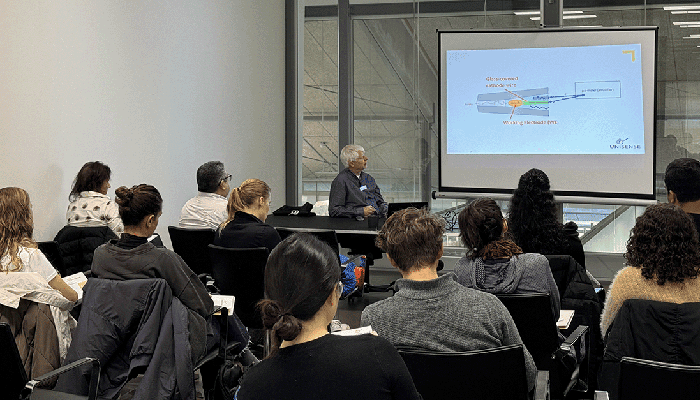Build your microsensor knowledge
Welcome to the Unisense Microsensor Academy
In this series of web lectures, you can get a detailed overview of microsensors, and build your knowledge of specific sensor types.
Enjoy the lectures and let us know, if you have any feedback or questions. You can get in touch at sales@unisense.com.

Web lecture
Amperometric Microsensors
Description and time stamps:
00:00 Introduction
01:04 Design and function
02:38 Electrochemistry
09:26 Signal control
14:56 Effect of polarization
18:01 Linearity and concentration range
20:50 Does a sensor measure concentration or partial pressure?
32:14 Temperature influence
38:44 Stirring sensitivity
42:54 Response time control
45:47 Specificity and interferences
00:00 Introduction
01:04 Design and function
02:38 Electrochemistry
09:26 Signal control
14:56 Effect of polarization
18:01 Linearity and concentration range
20:50 Does a sensor measure concentration or partial pressure?
32:14 Temperature influence
38:44 Stirring sensitivity
42:54 Response time control
45:47 Specificity and interferences

Web lecture
Potentiometric Microelectrodes
Description and time stamps:
00:00 Introduction
01:13 Measuring principles
02:22 Need for high impedance voltmeter
04:24 Reference electrodes and calibration
05:35 Combination electrodes
08:06 Interference from electrical noise
08:53 Electrical fields in setups
00:00 Introduction
01:13 Measuring principles
02:22 Need for high impedance voltmeter
04:24 Reference electrodes and calibration
05:35 Combination electrodes
08:06 Interference from electrical noise
08:53 Electrical fields in setups

Web lecture
Sensor types, meters and amplifiers
Description and time stamps:
00:00 Introduction
00:29 Detection principles and amplifiers
01:21 Amperometric microsensors
02:56 Potentimetric microelectrodes
03:39 MicroOptodes
04:26 Temperature sensors
04:56 Underwater amplifiers
06:11 STOX sensors
00:00 Introduction
00:29 Detection principles and amplifiers
01:21 Amperometric microsensors
02:56 Potentimetric microelectrodes
03:39 MicroOptodes
04:26 Temperature sensors
04:56 Underwater amplifiers
06:11 STOX sensors

Web lecture
Oxygen Microsensors
Description and time stamps:
00:00 Introduction
01:09 Tip design and detection principle
03:13 Specifications
09:35 Customizations
10:30 Troubleshooting

Web lecture
O2 MicroOptodes
Description and time stamps:
00:00 Introduction
00:55 Tip design and detection principle
09:34 Specifications
13:07 Troubleshooting
00:00 Introduction
00:55 Tip design and detection principle
09:34 Specifications
13:07 Troubleshooting

Web lecture
H2S Microsensors
Description and time stamps:
00:00 Introduction
01:52 Tip design and detection principle
06:15 Specifications
13:07 Customizations
14:07 Troubleshooting

Web lecture
SULF Microsensors
Description and time stamps:
00:00 Introduction
01:32 Tip design and detection principle
04:33 Specifications
11:21 Customizations
12:19 Troubleshooting
00:00 Introduction
01:32 Tip design and detection principle
04:33 Specifications
11:21 Customizations
12:19 Troubleshooting

Web lecture
H2 Microsensors
Description and time stamps:
0:00 Introduction
00:56 Tip design and detection principle
02:37 Specifications
07:59 Customizations
09:01 Troubleshooting
0:00 Introduction
00:56 Tip design and detection principle
02:37 Specifications
07:59 Customizations
09:01 Troubleshooting

Web lecture
N2O Microsensors
Description and time stamps:
00:00 Introduction
01:09 Tip design and detection principle
05:01 Specifications
12:01 Customizations
13:01 Troubleshooting
00:00 Introduction
01:09 Tip design and detection principle
05:01 Specifications
12:01 Customizations
13:01 Troubleshooting

Web lecture
NO Microsensors
Description and time stamps:
00:00 Introduction
01:08 Tip design and detection principle
03:44 Specifications
10:09 Customizations
11:09 Troubleshooting
00:00 Introduction
01:08 Tip design and detection principle
03:44 Specifications
10:09 Customizations
11:09 Troubleshooting

Web lecture
pH Microelectrodes
Description and time stamps:
00:00 Introduction
00:51 Tip design and detection principle
06:27 Specifications
14:43 Customizations
19:31 Troubleshooting

Contact us
Send a message to Line, Maiken, and Tage. They will answer within one workday.
If we are online and available to chat, you can also click the green icon to the right.

